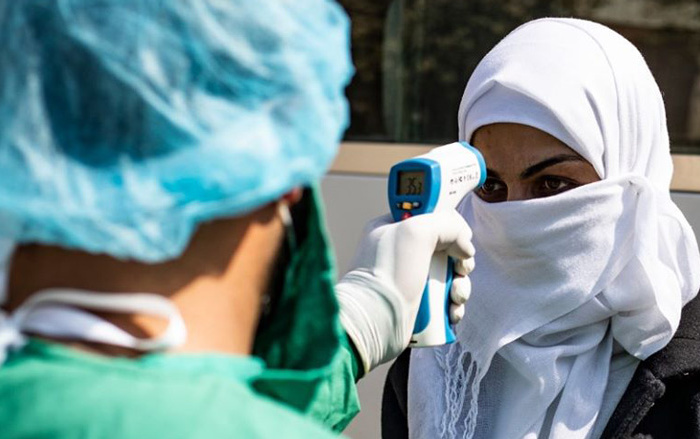A healthcare worker checks the temperature of a woman arriving in Syrian Kurdistan (Rojava) from Iraqi Kurdistan, February 26, 2020 (Delil Souleiman/AFP)
Coronavirus cases have surged in Kurdish-held northeast Syria, fueling concerns of widespread fatalities.
Since August 1, the number of cases has risen from 28 to 556 cases, including the first infection in the overcrowded al-Hol camp for former Islamic State fighters and their families.
The caseload is magnified by the low testing rate of 404 per million people and the highest positivity rate — about 30% — in the country. In Qamishli, only 60 to 70 tests can be performed a day by the sole lab team in the city. Contact tracing is close to impossible because of the “sheer number of contacts” and lack of tracing teams.
A Western aid worker tells Syria Direct, “It’s a ticking time bomb; we’re maybe a month behind Damascus in terms of the COVID outbreak.”
The Assad regime has only acknowledged 2,830 cases and 116 deaths in its areas of Syria. Medics, activists, and residents say that the official figure is a massive under-reporting of the outbreak — a model from the London School of Economics projected 2 million infections by the end of August without containment measures.
In the northeast, the Western aid worker cited lack of coordination between the central Kurdish autonomous administration and local authorities, resulting in tough lockdowns in some area but few restrictions in others.
Entry from regime-held territory also continues, with Qamishli airport under control of Assad officials. About 3,500 passengers fly into Qamishli from Damascus each week.
Transmission may also be fed by doctors who have to work in up to four medical centers at once. Only 27 of the 478 cases, as of August 27, were put into isolation facilities or hospitals; instead, patients were sent home to await results.
Medical aid has been restricted by the closure of the al-Yarubiyah border crossing from Iraq, forced by a Russian veto in the UN Security Council in January.

